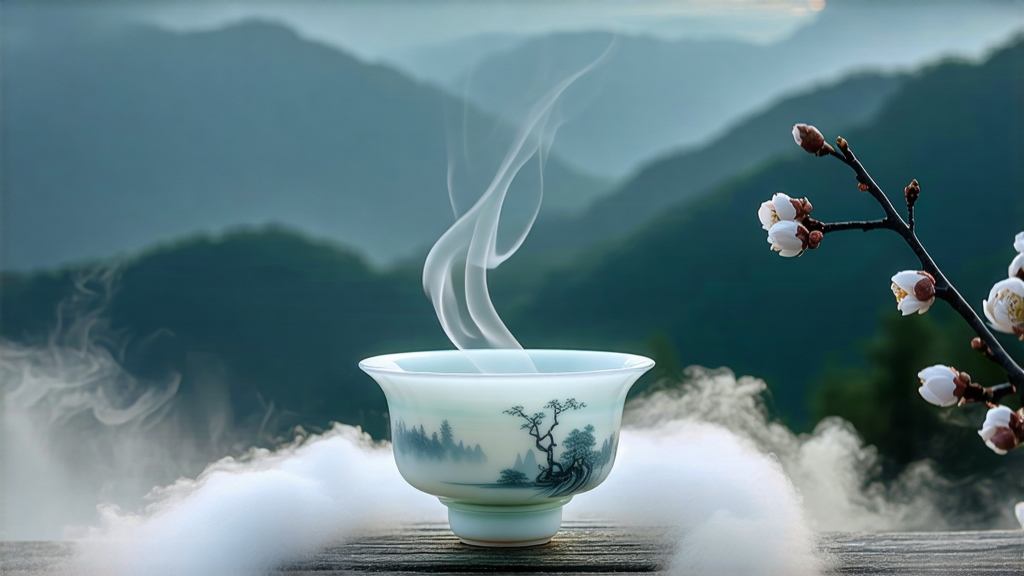
High on the northern horn of Fujian province, where the Wuyi Mountains soften into the East China Sea, March mornings arrive wrapped in a pearl-gray fog so thick it seems to muffle time itself. From this humid hush emerges the most aristocratic of all white teas—Bai Hao Yin Zhen, literally “White Hair Silver Needle.” International drinkers often meet white tea through bagged blends labeled merely “white,” yet to understand China’s tea imagination one must confront this single-origin, single-bud marvel whose silhouette resembles a slender filigree of mined silver and whose flavor carries the cool breath of the sea.
Historical whispers place Yin Zhen’s birth during the early Qing dynasty, circa 1796, when the imperial court still demanded tribute tea pressed into moon-shaped cakes. Legend claims a tea garden near Taimu Mountain was spared the blade of a passing typhoon; the surviving buds, covered in gossamer down, were hastily dried yet astonished the magistrate with their honeyed, almost salt-sweet liquor. By the late nineteenth century Fuding county bureaucrats had codified the picking standard: only the unopened bud, plucked for a fleeting week before Qingming festival when the dew still weighs more than the leaf itself. Thus Silver Needle became the first Chinese tea whose value was measured not by volume but by the countable number of intact tips.
Strictly speaking, genuine Bai Hao Yin Zhen hails from two micro-zones: Fuding, with its granitic, slightly acidic red soils, and the cooler, higher Zhenghe county. Each terroir stamps the bud: Fuding versions show a plush, silvery sheen and a brighter, marine aroma, whereas Zhenghe buds carry a faint iron-mineral note and a creamier texture. Beyond geography, cultivar matters. The traditional Fuding Da Bai Hao (“Big White Down”) bush, a seed-selected variety with unusually fat buds, accumulates more amino acids than ordinary Camellia sinensis, translating into the famous “sweet broth” character. A newer clonal variant named Fuding Da Hao, bred for down density, now dominates export gardens, yet connoisseurs still chase old-tree plots whose deeper roots pull maritime trace minerals into every filament.
Processing Silver Needle is an exercise in restraint. Once baskets of dawn-plucked buds reach the farmhouse, they are spread no thicker than two fingers on woven bamboo trays and left to wither under nature’s own choreography—sun-warmth by day, mountain chill by night—for up to 48 hours. No pan-firing, no rolling, no kneading interrupts the enzymatic daydream. Master crafters speak of “reading the sky”: if humidity climbs above 70 %, buds are moved indoors where gentle wind furnaces mimic the sea breeze. The goal is to coax moisture down to 8–10 % while preserving the downy ‘bai hao’ that acts as a natural antioxidant shield. A final charcoal bake, so light it is more gesture than heat, sets the fragrance. The entire craft is inscribed on China’s National Intangible Cultural Heritage list, yet paradoxically demands the least manipulation of any tea type, proving that sometimes the highest art is knowing when not to act.
Western tea guides often repeat the mantra “white tea is low in caffeine,” a simplification that collapses under scrutiny. Bud-exclusive Silver Needle actually contains more caffeine by dry weight than many green teas; what tempers the kick is the leisurely infusion style and the high ratio of protective amino acids, especially L-theanine, which smooth caffeine’s jagged edge into a sustained, meditative alertness. The liquor’s color, too, defies expectation. Rather than pale, it can glow like antique ivory, especially when brewed with 85 °C water that coaxes carotenoids from the bud’s hidden core.
To infuse Silver Needle respectfully, begin with a tall, thin-walled gaiwan or a glass pitcher whose height allows the needles to stand vertically—an elegant “bud dance” that signals liveliness. Use 3 grams, roughly two heaping teaspoons, for 150 ml of water. First rinse at 80 °C for five seconds; discard not for cleanliness but to awaken the down. Subsequent steeps ascend slowly: 30 seconds, 45, then a minute, each revealing a new stratum. The opening infusion smells of fresh alfalfa and steamed rice; the middle turns to honeydew and white peach